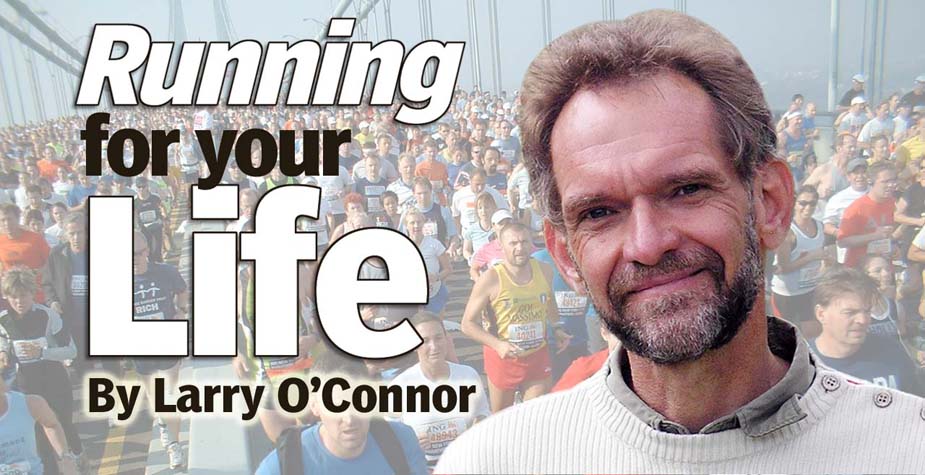We don’t really know why Don Draper starts keeping a journal. He’s gotta be in his early 40s now, and as a typical guy in the Sixties, particularly THAT type of guy, the “Mad Men” star would never do such a thing. No, Draper’s journal-keeping is a story-driven anachronism for sophisticated watchers in late 2010 so that their hero will give voice to his innermost thoughts. He says, “I feel like a girl” keeping a diary. But serious watchers of the best show on TV don’t judge it for taking such an historical license; rather, we are ready to learn, not only what we see from the behavior of this complicated, creative survivor, but from his deepest thoughts, which can best come from keeping a journal.
*
I’ve been keeping a regular journal since 1983. Seven years after I started running. In the past year, I’ve given a lot of thought to the years that I was running when I wasn’t keeping a journal. Like Draper’s journal, the practice serves as a critical first draft of understanding – and dipping into it, you can best connect the dots to earlier times. As I said earlier in this blog, in a long life we think of ourselves as many distinct people as we pass through our various changes. And as poet Stanley Kunitz, who died at 101 in 2006, said in a poem late in his life, “I am not yet done with my changes.”
*
I was in Nicaragua in 1985 when I wrote: “Running is not an excuse for abject solitariness – but for real enjoyment. The sweat pours down my forehead. My left leg, of course, throbs with the pain of too much pounding. But the second wind comes along, and the leg . . . almost in concert . . . begins to loosen, the pace is now regular and forever does not seem such a long time. Home and the final stretch. I’ve managed to run another 10 miles.”
*
Runners don’t need to start a journal. But I find journal-keeping helps. Especially on long runs.
For Week Four I need to do a long run. On Tuesday, the forecast is for a break in the heat and humidity, cool, a bit of rain. The day before I’m in the park for a typical one-hour training run, up the steps of the stone staircase to amp up the cardio. Once again, I don’t pay attention to how many miles I’m doing, rather it is all about the pace. If I can keep my ’thon pace, which is in the 8 minute, 30 second range, I’m pushing myself hard enough to reach my goal: a 3:45 marathon in October and a shot at Boston in April.
People ask me what I think about when I’m running. For me, since June 1983, when I left for a year’s trip across America, and on to Tahiti, New Zealand, Australia, Mexico and Cuba, running and writing have been intimately linked. I don’t stop to take notes, but I keep my mind active, I think of stories that I want to tell, details I have to write down when I get home.
On Tuesday of Week Four, I decide to run to Green-Wood Cemetery. M told me she’d read somewhere that at one time Green-Wood Cemetery in Brooklyn was the number two tourist attraction in the state behind Niagara Falls. Bigger than the Statue of Liberty and the Brooklyn Bridge. Realtors are taking to calling the district Greenwood Heights. Still, although I’ve lived in the borough for almost twenty years, I’ve never gone to the cemetery.
Soon, I’m making my way toward the Gothic entrance. Somewhere a sign reads: Established 1838. And another one: K9 Patrol and 24-hour armed guard, who must be the guy who is getting up and out of his seat as I approach. I’ve run in cemeteries: a namesake one in my hometown of Owen Sound, Ontario, and Hollywood Cemetery in Richmond, Va., where I met my wife (in the city, not the cemetery!), and in Ireland, on two separate trips. The guard is shooing me away, looking like he could go for his gun, but I keep coming, indicate with my hands that I want to talk.
“Can’t I go inside,” I say.
The guard shakes his head. “No. This is a cemetery, not a park.”
That seems the final word, so onward. Finally, a bit of cool rain. I’m sure, I think, my spirits picking up, I can get in a two-hour run.
But sadly, not inside. A notice board by the entrance seems to suggest you have to arrange for a tour to see the rolling hills, the botanic garden-like plantings and myriad monuments.
Outside, though, are urban treasures to be seen in the hourlong run skirting the perimeter, with few views of names of the headstones themselves (except for a patch along 20th Street, between Seventh and Eighth avenues): the Jackie Gleason depot that I imagine is little changed from “The Honeymooners” and Dodgers time, a burned out car along Gautier Way, Shannon Florist along Fort Hamilton Parkway, where Spanish-speaking workers huddle, waiting for a work truck.
Then, the pleasures of Windsor Terrace, before I get to Prospect Park and, yes, manage twice around, even getting into the woods, and its ground-worn trails. And when I arrive at home, after gobbling down a sheath of electrolyte cubes, and downing a bottle of cold tap water, I take out my journal and write: Jackie Gleason depot, the Green-Wood security standoff, a thread of a park off Sixth Avenue and the Prospect Expressway, named after Detective Joseph Mayrose (1949-1989), a beloved Bay Ridge cop. And I make special note of Our Lady’s Field, the smallest baseball diamond I have ever seen, a field of dreams wedged in the center of a borough that I’m seeing in a way I never have before.
Next: Running for Your Life: Week Five
